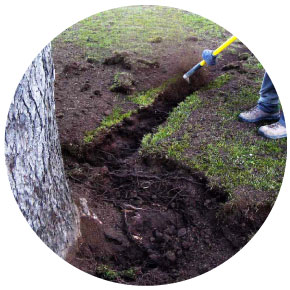Root Zone Aeration

The aeration of a tree’s root zone can become a necessary measure if the soil surrounding it has become too impacted. Closely clumped soil robs the tree of vital oxygen, creates a poor exchange of gases between the roots and soil, and eliminates beneficial soil organisms. These conditions often occur in urban environments, or in areas undergoing a large amount of construction activity.
Trees that are in need of root zone aeration may demonstrate symptoms like the early autumn coloring of its leaves, a lessened amount of leaves and dieback of its crown. This can make the affected tree more open to attack by diseases and pests, so the sooner the problem is identified, the better.
One method of aeration is “vertical mulching.” This process involves the drilling of holes, roughly 2” to 4” in diameter, into the ground surrounding the tree. The holes should have the depth of about 1’. While just these holes aid aeration, sometimes the insertion of materials such as peat moss and wood chips is recommended to maintain positive benefits and encourage the roots to grow.
Radial aeration is another option, one that’s implemented by using an air gun to cut trenches throughout the root zone. The trenches should begin at least four feet from the tree’s trunk, and be cut to a depth of about 8” to 12”. The cuts are then filled with material that will help stimulate new root growth, such as composted organic matter or topsoil.

